The Legend of Zelda: Skyward Sword is a video game released for the Nintendo Wii console in the year 2011, and is

The Legend of Zelda: Skyward Sword
the seventeenth video game released in The Legend of Zelda Franchise.
Hyrule[]
While certain landmarks of Hyrule commonly return, Hyrule's geography appears to be laid out
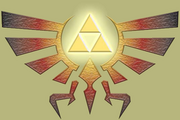
Hyrule Symbol
differently with almost every new game set in it. Parts of Hyrule found in one game's map may be in a different location, have different geographical features, or be completely absent in another. While some games may take into account the geography in past Zelda games (A Link to the Past and Four Sword Adventures share almost the same Hylian geography) others may completely ignore them (The Minish Cap's Hyrule bears almost no resemblance to any other game). Several fan explanations have been given. The first is that the changes occurred because of geological events between the games such as earthquakes, mudslides, erosion, forest growth, continental drift, or all of the above. The second theory is that Hyrule's geography stays relatively the same but that each new game shows the same Hyrule seen from a different angle, that landmarks are renamed, or that other unseen parts of Hyrule are seen each game. Some fans argue that while Hyrule does change from game to game it is simply due to gameplay
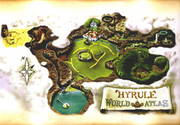
Hyrule Map
reasons to give players something new to explore while staying in the same land and has no real in-game explanations.
It is also possible that different parts of Hyrule are shown throughout the various games. In The Legend of Zelda comics, the map from Zelda II: The Adventure of Link is added to the north of the map found in The Legend of Zelda, and the in-game map for Zelda II: The Adventure of Link also has an area that resembles a scaled down version of the map in The Legend of Zelda. The geography then allows the map from A Link to the Past to be included to the west.
Book of Mudora[]

Book of Mudora
The Book of Mudora is also similar to the book that Gaepora holds in The Legend of Zelda: Skyward Sword.
Clawshot[]
It is possible that Clawshots are
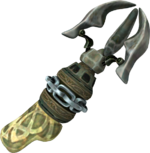
Clawshot
of Oocca origin, as a second Clawshot is found in the City in the Sky, along with numerous Clawshot-sensitive targets. The Oocca also seem to possess technology compatible with the Clawshot, such as the Sky Cannon and the numerous propellers supporting the city itself. However, the Clawshots from The Legend of Zelda: Skyward Sword potentially precede the Oocca or at least their technology.
Cloud Tops[]

Cloud Tops
Hailey and her sister, show surprise that Link is able to walk on clouds.
With the events of The Legend of Zelda: Skyward Sword in mind, it is also possible that the Cloud Tops could be the remnants of Hylia's Cloud Barrier, and the Palace of Winds a repurposed section of Skyloft.
The Wind Tribe may also be linked to the Oocca and their City in the Sky, perhaps being their human ancestors, alhough it is unknown if the Oocca already existed by this time. Alternately, both civilizations may exist concurrently and simply be unaware of each other, although given Siroc's claim that she knows much from listening to the wind, this is questionable.
Crimson Loftwing[]
It is possible that the red, eagle-like crest on the Hylian Shield represents a
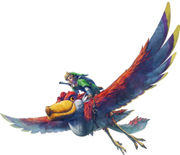
Crimson Loftwing
Crimson Loftwing, given its coloration and birdlike appearance.
Desert Province[]

Desert Province
It is possible that the Desert Province is the Lanayru Sand Sea featured in The Legend of Zelda: Skyward Sword, as the two share similar locations and shapes.
Demise[]
With his final breaths, Demise vows that his hatred and the curse of the Demon Tribe
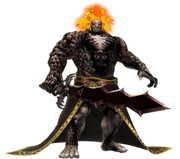
(in the Japanese version) will be reborn in a cycle without end as it evolves, cursing those with the blood of the goddess and the spirit of the hero. After Demise's body dissolves, his residual consciousness is absorbed into the Master Sword before the weapon is sealed away so the fiend can completely dissolve over time.
Demise's curse seems to signify the reasons for Ganondorf and the other villains existence and the tribulations that they cause for Link and Zelda's various descendants. This idea is supported by Demise's similar appearance to Ganondorf, Ganondorf's frequent appearances throughout the series, and Eiji Aonuma's statement that Ganondorf's appearance in The Legend of Zelda: Ocarina of Time would be hinted at inSkyward Sword.
Din(Goddess)[]
- "Din... With her strong flaming arms, she cultivated the land and created the red earth."
- — Great Deku Tree
Din, the Goddess of Power, is a recurring character in the Legend of Zelda series. She is one of the three Golden Goddesses ofHyrule. Din, along with her sisters Nayru and Farore, came down from the heavens and created Hyrule out of the chaos the land formerly was, each contributing her part in the process. Din, the Goddess of Power, formed the terrain of Hyrule. Upon departure, the three goddesses left the Triforce, the essence of their power, in the Sacred Realm. As the goddess of power, Din is closely associated with the Triforce of Power.
The spell Din's Fire was named after her. The Oracle of Seasons,Din of Holodrum, is named after the Goddess of Power. Din's Pearl, belonging to the Rito people, was also named after her, and said to have once belonged to her. Eldin Province, a province of Hyrule featuring volcanic mountains, is named in her honor. The Light Spirit, Eldin, and its spring were also named after her likeness. In addition, the dragon Eldin is named after the goddess. Her symbol is the Mark of Din.
Goddess of the Sand[]
It is speculated that Din is the Goddess of the Sand that the Gerudo worship. Some evidence supporting
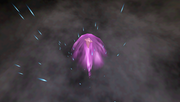
Din
this theory is that Farore could supposedly be the "Goddess of Wind" spoken of in The Legend of Zelda: The Wind Waker and Nayru could supposedly be the "Goddess of Time" spoken of in The Legend of Zelda: Majora's Mask. (Note, Farore could also be the goddess of time, as Ciela is the spirit of courage and time in The Legend of Zelda: Phantom Hourglass, and Farore is the definitely the goddess of courage. Also, the mark of Nayru is on the Isle of Gust in the same game, so she would most likely be the goddess of wind (also, wind tends to be associated with sand). One contradiction, though, is that Lanayru in The Legend of Zelda: Skyward Sword, has an abundance of Timeshift Stones. The Arbiter's Grounds in Twilight Princess contain statues resembling the Goddess of Sand, holding flames; fire is often closely associated with Din. She would also be indirectly connected to the Gerudo tribe through Ganondorf's Triforce of Power. However, some contradictions to this theory include Din's Fire being found outside Hyrule Castle, while Nayru's Love is found at the Desert Colossusnear the Gerudo's home. Furthermore, the idea that Nayru is the Goddess of Time and Farore is the Goddess of Wind is only speculation. A further refute is that in The Legend of Zelda: Skyward Sword, Lanayru Desert is named after Nayru and not Din. The region, however, could have just retained the name as it was a cliff and sea area before.
Mountain Goddess[]
Some theorize that Din is the Mountain Goddess from The Legend of Zelda: Spirit Tracks. Din is known for creating the earth and its features, which would include mountains. It is possible that, over time, her name faded out of memory and she came to be referred to as the Mountain Goddess. However, the Mountain Goddess has never been mentioned in any games other than Spirit Tracks, by the Gorons or any other race. Also, the eruptions believed to be caused by the Mountain Goddess were in reality caused by Cragma. This may indicate that the Mountain Goddess may not even be real.
Earth Temple[]
The Earth Temple has much in common with Dodongo's Cavern from The Legend of Zelda: Ocarina of
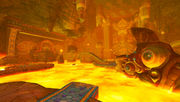
Earth Temple
Time. Both dungeons are the second in their respective games and are located near volcanoes. The Bomb Bag is the main item and many Bomb Flowers can be found within the dungeons. Also, they both have two Lizalfos as their mini-bosses and both of their bosses are defeated by throwing bombs in their mouths while they are inhaling. Because of this, the Earth Temple and Dodongo's Cavern may share some kind of connection. The first theory may indicate that Dodongo's cavern is a part of the former Earth Temple, or at least why the two areas share a similar ecosystem and have many of the same enemies. thumb|link=The Legend of Zelda: Ocarina of

Earth Temple
Time. Both dungeons are the second in their respective games and are located near volcanoes. The Bomb Bag is the main item and many Bomb Flowers can be found within the dungeons. Also, they both have two Lizalfos as their mini-bosses and both of their bosses are defeated by throwing bombs in their mouths while they are inhaling. Because of this, the Earth Temple and Dodongo's Cavern may share some kind of connection. The first theory may indicate that Dodongo's cavern is a part of the former Earth Temple, or at least why the two areas share a similar ecosystem and have many of the same enemies.
Eldin Volcano[]
Due to its location, and the fact that it is the only mountainous area in Hyrule at the time of
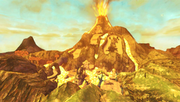
Eldin Volcano
Skyward Sword, Eldin Volcano may eventually be known as Death Mountain.
Faron(The Legend of Zelda: Skyward Sword)[]
Faron bears a vague resemblance to the Zora which appear in other games, both being generally
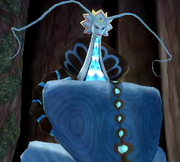
Faron
humanoid, semi-aquatic, blue skinned species with somewhat fish-like characteristics that live in the only large fresh-water body in Hyrule. The Water Dragon's Scale gives Link an ability similar to, though more powerful than, the Silver Scale and the Golden Scale, suggesting that the two may be related. It is possible that the Zora are either descendants or creations of Faron. It has already been shown that Faron can create life with her Tadtones. It is also possible that the Tadtones themselves were the early forms of Zora, as they resemble the infant Zora seen in The Legend of Zelda: Majora's Mask, which also have a tadpole like appearance and convey a musical composition.
Farore(Goddess)[]
If Farore is indeed the Goddess of Wind as Tingle states, the Wind Temple may be dedicated to
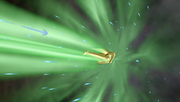
Farore
her.
Since Link holds the Triforce of Courage and is the Hero of Time, Farore may be the Goddess of Time. Evidence supporting this theory is the fact that Ciela, the Spirit of Courage, is also the Spirit of Time. Her symbol is also the Mark of Farore.
Fi[]
It is quite possible that Fi still resides in the Master Sword while in her eternal slumber,
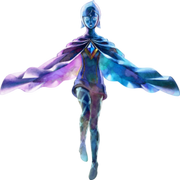
Fi
remaining inactive and unaware of outside events. This would mean she would have been lying dormant within the Master Sword during the adventures of the various future incarnations of Link who wielded it. Therefore, in a sense, she would have fulfilled her wish of meeting Link again, though they would be different Links, and Fi would presumably not be fully aware of the meeting.
Gate of Time[]
It is possible, perhaps even probable, that the Gates of Time were made out of Timeshift

Gate of Time
Stones, albeit refined ones. While being activated, the second Gate of Time initially consists of a series of cuboid structures which are covered in markings similar to those on Timeshift Stones, and although their color is different, it does faintly resemble the bluish light given off by active Stones. While the Gate is being assembled, its pieces are also shown to rotate and fit together in a very specific manner, likely as a way to redirect and focus the fields normally given off by Timeshift Stones. This could be what allows the Gate to open a portal back through time in a specific area, as opposed to transporting everything in a certain radius back through time.
Goddess Butterfly[]
The Goddess Butterfly resembles the Blessed Butterfly from The Legend of Zelda: Skyward Sword,
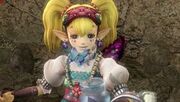
Goddess Butterfly
meaning the Goddess Butterfly may be either a related species or simply another name for them. This is further supported by their function in Adventure Mode, as using the Goddess's Harp on any Goddess Butterflies space will cause a Gossip Stone to appear just as playing the Harp next to a flock of Blessed Butterflies may cause a Gossip Stone to appear in Skyward Sword.
Goddess's Harp[]
The Goddess's Harp resembles the Harp used by Sheik in Ocarina of Time[1]. This could be meant
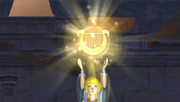
Goddess's Harp
to show that the Goddess's Harp will become an heirloom of the Hyrulean Royal Family. In the Earth Temple Sanctuary, Zelda is seen using the harp to open a magical portal which warps her and Impa to the Lanayru Desert, in the same way that Sheik teaches Link melodies that allow him to warp to different temples. In Hyrule Warriors, the Goddess's Harp appears as Sheik's default Harp further supporting the idea that the Goddess's Harp is an heirloom of the Royal Family of Hyrule.
Gratitude Crystal[]
Gratitude Crystals resemble Star Bits from Super Mario Galaxy and Super Mario Galaxy 2. As

Gratitude Crystal
characters from the Mario series have had cameo appearances in several past installments of the Legend of Zelda series, it is possible this was an intentional design choice.
Another possibility is that they are visually based on Star Fragments from The Legend of Zelda: Spirit Tracks. It is also possible that they could also be based on Force Gems, due to their propensity to appear when someone is grateful.
Hero of Time[]
The Hero of Time is a character mentioned in The Legend of Zelda: Ocarina of Time. According to Rauru, when Link opens the Door of Time and removes the Master Sword from the Pedestal of Time, he attempts to take up the title of the Hero of Time. However, as he is a child, he is unable to do so and as a result he is put into a deep sleep until he has physically grown enough to awaken as the Hero of Time. The Hero of Time is apparently chosen by the Master Sword itself with the express purpose of fighting alongside the Seven Sages. Little else is known about the original Hero of Time though Sheik states that Link, when holding the Master Sword, greatly resembles the Hero of Time meaning it is possible the original Hero of Time is a past incarnation of Link from another game, most likely The Legend of Zelda: Skyward Sword.
Prophetic Figure[]
It is never outright stated that there was another Hero of Time before the Link of Ocarina of Time appeared. Sheik's comment about Link resembling the Hero of Time can be interpreted two ways: The first is Sheik was referring to the original Hero of Time or previous incarnation of Link who held the title, however the second interpretation is that given that several characters have demonstrated the ability to have prophetic visions and dreams (Zelda and Link being notable examples), it is possible that at some point someone (such as a member of the Sheikah, a incarnation of Zelda, one of the Light Spirits, Great Deku Tree, or one of the Sages) prophesized the emergence of the Hero of Time (Adult Link from Ocarina of Time). Thus said prophecy (or prophecies) would explains why Sheik said Link resembled the Hero of Time, as he was the very person the prophecy spoke off and Sheik simply meant that Link resembles the prophesized Hero of Time. Also given the fact that Sheik is actually Zelda, it is possible that she herself may have had a prophetic vision of the Hero of Time before she encounter Link under the guise of Sheik (possibly during the seven years Link slept).
Original Hero of Time: The Hero of Skyloft[]
The most likely candidate for the Hero of Time is the Link from The Legend of Zelda: Skyward Sword as it takes place before Ocarina of Time. Given his role in the creation of the Legendary Blade of Evil's Bane, the Master Sword, his role in defeating the Demon King Demise, and his possible involvement in the creation the Kingdom of Hyrule, anyone of these feats may have contributed to him becoming known as the Hero of Time.
Legendary Heroes of Time[]
Another possibility is that the Hero of Time was a title used to referred to a past incarnation or incarnations of Link that preceded the events of Ocarina of Time (as there may have been other incarnations of Link in between the events of Skyward Sword & Ocarina of Time), which have become legendary figures only spoken of Hyrule's various myths and legends. The Link in Ocarina of Time is bestowed the title likely due to his resemblance to the past Hero (or Heroes) of Time that preceded him.
Wielder of the Blade of Evil's Bane[]
It is also possible that that title is meant to be bestowed onto the one capable of removing the Master Sword from the Pedestal of Time and wield the Legendary Master Sword. Thus Sheik was simply saying that Link resembled the previous wielder of the Sword. However it is likely that this custom was forgotten or fell out of use after the Link's defeat of Ganon in Ocarina of Time, likely because the title became too closely associated with the first Link to face and defeat Ganon.
Hero's Bow[]
Because the Link in The Legend of Zelda: Skyward Sword was the first hero chosen by the Gods,

Hero's Clothes
and the knights are seen wearing the Hero's Clothes, it is possible that this is where they originated from, and from this Link they have been passed down. It is more likely however, that the Hero of Time was the one who passed down the idea as shown in Wind Waker and Twilight Princess.
Lake Floria[]
It is possible that Lake Floria may have become the Zora's Domain or Lake Hylia. This is
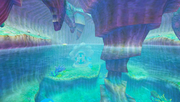
Lake Floria
supported by the fact that Lake Floria is the only large body of water seen during the events of Skyward Sword, and its location relative to the overall map is similar to the location of Lake Hylia in other games in the Zelda series. In addition, the underground cavern of Lake Floria bears some resemblance to the appearance of Zora's Domain.
Lanayru Desert[]
Given Lanayru Desert's environment and approximate position relative to the only volcano and
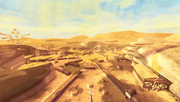
Lanayru Desert
forest shown in the game, it is possible that part of it later becomes Gerudo Valley from The Legend of Zelda: Ocarina of Time and/or Gerudo Desert from The Legend of Zelda: Twilight Princess.
Lanayru Sand Sea[]
Due to the similar climate and location, the Lanayru Sand Sea could be related to or be the

Lanayru Sand Sea
same as the Haunted Wasteland from The Legend of Zelda: Ocarina of Time. Another similarity is that they both have quicksand as the majority of their land.
Another possibility is that the Desert Province from The Legend of Zelda: Twilight Princess is Lanayru Sand Sea, as the two are in similar relative positions and share similar geographical features.
Link[]
Reincarnation[]
A common theory as to why each incarnation of Link looks similar and have similar abilities is
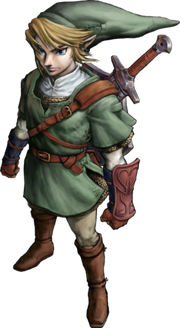
Link
that they are reincarnations of one another. It is notable that when Demise put a curse onto the Skyward Sword, Link, and Zelda, he stated "Those like you... Those who share the blood of the goddess and the spirit of the hero." which may have been referring to reincarnation. It should be noted however, that Link from The Wind Waker could not be the reincarnation of the Hero of Time since the latter went to the Child Timeline and effectively disappeared from the Adult Timeline. According to the King of Red Lions, the Hero of Winds has no connection to the Hero of Time, though it is unclear whether he is referring to blood relation or reincarnation with this statement. It is worth noting that Ganondorf believes the Hero of Winds is the Hero of Time reborn, though his claim has no concrete evidence. Link from Twilight Princess also could not be the reincarnation of the Hero of Time since, according to Hyrule Historia, he not only met the Hero of Time as the Hero's Shade, but is however his descendant.
Relatives[]
Another theory as to why each incarnation of Link looks similar to one another is that they are actually related to one another. This is supported by the fact that the Hero of Time is the ancestor of Link in Twilight Princess as well as how it is stated in A Link to the Past that the Master Sword can only be pulled out from its pedestal by the ones who carry the bloodline of the Knights of Hyrule. It is possible that when Demise stated "Those like you... Those who share the blood of the goddess and the spirit of the hero," when he put a curse on Link and Zelda, he was actually referring to the "spirit of the hero" as a form of will or a set of personality traits rather than the soul itself. If this is the case, this could explain each Link's connection with the Triforce as well as their abilities in physical, mystical, and spiritual ways.
This may mean when he was stating "Those who share the blood of the goddess" he was referring to Skyward Sword Link and Zelda's descendants as the other incarnation of Links rather than the Royal Family of Hyrule, where an alternate reason for the Royal Family having magical powers is the Light Force as hinted in The Minish Cap. This would explain why Link faces other adversaries aside from Ganon, with Zelda (or other members of the Royal Family) sometimes not being present to support the side of good in games such as as Majora's Mask, Link's Awakening and Tri Force Heroes The original Japanese text that Demise states is that his hatred and the Demon Tribe will go under an "evolution", which may mean the curse could involve other villains apart from Ganon himself.
If each Link is related to one another, they need not be related along a single line of descendants. For example, the Hero of Winds cannot be a direct descendant of the Hero of Time since the latter returned to the Child Timeline immediately after his victory over Ganon while being a young preteen in a teenager's body, but provided the Hero of Winds can trace his lineage to Skyward Sword Link, the theory still holds. It is possible that the reason why the Master Sword can only be pulled from it's pedestal by someone who carries the bloodline of the Knights of Hyrule is actually a sub-conscience decision by Fi, who is the spirit of the Master Sword.
Madas[]
It is possible that in the contemporary Hylian language during the events of Skyward Sword, Link's name may be "Madas" when pronounced. This would explain why Fi, when talking to Link in dialogue that uses his name, often says "Madi Madas" with "Madi" possibly being "Master" in the language. Alternatively, it is possible that Fi's words are gibberish used repetitively in the game, similar to Midna in Twilight Princess.
Lizalfos[]
The Lizalfos are probably related to a variety of other, similar, reptilian species. Lizalfos
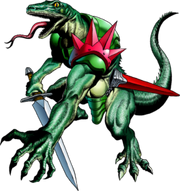
Lizalfos
are commonly identified as being related to the Dinolfos, although this is easily debatable due to the lack of information between the two species. Dairas are also a likely relative, due to the similar appearance and their use of primitive weaponry. Yet another potential relative are the Tokay, another primitive reptilian species.
Loftwing[]
It is possible that Loftwings are the inspiration of the birdlike part of the crest of the
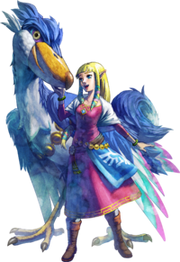
Loftwing
Royal Family of Hyrule, which is, among many other places, found on the Hylian Shield.
Mushroom Spores[]
Southwest of Skyloft and just east of the entrance to Lanayru Desert, inside a cave there is a small island with mushrooms like those found in Faron Woods. Presumably this island is where the Mushroom Spores that Parrow gives to Link came from and serves as the source for Mushroom Spores used treat injured Loftwings by the inhabitants of Skyloft.
Parcella[]
It is possible that the Parella evolved into the Zora sometime after the events of Skyward
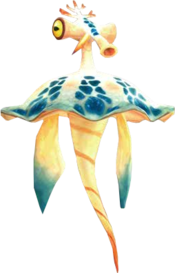
Sword, due to their slight resemblance. Additionally, concept art from the Hyrule Historia implies that the Parella's design was based off of the Zoras'.
Multiple Ganon Theory[]
The Multiple Ganon Theory is the theory that there exists more than one Ganon/Ganondorf in the Zelda timeline, in much the same way that Link and Princess Zelda exist as more than one person throughout the Legend of Zelda series. Variations include ideas that Ganondorf is locked in the same cycle of reincarnation as Link, or that Ganon is a malevolent demon who possesses people, Ganondorf being one such host. Supporting the reincarnation idea, it is said by the Gerudo that only a single male is born into their tribe every one hundred years. Depending on the game, he is said to be destined to become either the King of the Gerudo or the guardian of the desert and the Gerudo.
Although the theory has been around for quite some time, most modern versions of this theory stem out of Ganondorf's back-story in The Legend of Zelda: Four Swords Adventures, which conflicts with Ganondorf's back-story in The Legend of Zelda: Ocarina of Time. In Four Swords Adventures the Gerudo talk about a man named Ganondorf who had been born and lived in the Desert of Doubt with them. They mentioned that he had grown into an evil man with a lust for power and had broken their laws by stealing a Trident deep in the desert that gave him incredible powers, such as transforming him into Ganon.
This is in direct contrast to the back-story Ganon was given in Ocarina of Time, in which he is acknowledged by many as the king of the Gerudo, and does not become Ganon until acquiring the Triforce of Power. Additionally, the back-story of The Legend of Zelda: Twilight Princess, which explains the actions of the Ganondorf from Ocarina of Time in an alternate timeline, says that a tribe of thieves, most likely the Gerudo, followed him in his attack on Hyrule, again showing that he was accepted as king.
There are only three logical explanations to these conflicting back-stories:
One is that a single Ganondorf had ventured to the desert and stolen the Trident, broke out of the seal he was placed at at the end of Four Swords Adventures but was not killed by Link, turned back into Ganondorf, and returned to the Gerudo later at a time that they were willing to acknowledge him as king. This would require that Four Swords Adventures take place before Ocarina of Time. The second explanation is that the game is not part of the overall storyline within the series, though official statements indicate that all the games from the main series are included in the official timeline document. The third explanation is that the Ganondorfs from the two games are separate incarnations, much like the many Links, Zeldas, and other characters who are seen multiple times throughout the series. This theory is supported by a quote at the end of Four Swords Adventures in which Princess Zelda calls Ganon an "ancient demon reborn". This is similar language to a line in The Legend of Zelda: The Wind Waker in which Ganondorf calls the game's incarnation of Link "The Hero of Time, reborn". Another solid point for this theory is the apparent death of Ganondorf/Ganon five separate times throughout the series. An individual Ganon is only shown to be resurrected once. Even with this resurrection, and the split timeline allowing a single individual Ganon to die twice, there would still need to be three separate Ganons in order to account for all of the presumed deaths. In order for all of the Ganons in the series to be the same, Ganon would have to have been brought back to life on two additional occasions not hinted at by any of the games, or survived at least two of his apparent deaths.
In The Legend of Zelda: Skyward Sword, Demise states that his hatred will be reincarnated and attack in a cycle without end. This is often interpreted as meaning that Ganon's repeated appearances are a result of this cycle. If Ganon as we know him is a result of Demise's hatred continuously reincarnating itself, there would be further support for the idea that multiple Ganons could continue to appear even as previous ones are slain. This would support the Multiple Ganon Theory as each Ganon would be a separate incarnation in this cycle, though all of them would share the same basic origin of forming from Demise's hatred.
While the Multiple Ganon Theory has yet to gain wide spread acceptance, it has nonetheless gained the respect of some timeline theorist and fans of the series.
Shigeru Miyamoto has stated that although each Link and Zelda are reincarnations, there is "only one Ganon". However, this statement may now be outdated or may have been made based on a lack of information, as Miyamoto is no longer as involved with the Zelda storyline as he previously was.
According to the Hyrule Historia, a second Ganondorf is born during the events leading to Four Swords Adventures. The book either implies or states directly that the rest of Ganon's appearances are the same being brought back to life, or versions of him in alternate timelines.
Princess Zelda[]
The relationship Zelda has with Link is close, possibly her closest. A popular theory among
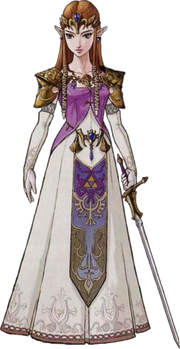
fans is that of a romantic relationship between some of the Zelda and Link characters in the Zelda series. Although never explicitly confirmed in a video game title, this theory is based on hints given in the games, interviews with the game creators, and content of the animated series, comics, and manga (although the last three are generally considered non-canonical).
One hint of a romance between Zelda and Link is given at the end of The Adventure of Link, when the awakened Princess apparently kisses Link under the falling curtain.
Some cutscenes in Ocarina of Time featuring the two together have been interpreted as signs of an attraction. While Link and Zelda are escaping Ganon's Castle, Zelda will additionally show her concern for Link by shouting out whenever he is hurt. Moreover, in the game's final scene, Zelda and Link are floating in the sky together, sharing a decidedly sentimental (if not necessarily romantic) moment where Zelda apologies for involving Link in the events of the game and seems saddened by the situation. She also stated that she will not forget the time she spent with him in the Child Timeline as shown in Majora's Mask through Link's memory.
In addition, if the Oracle games are played as sequels to each other, the ultimate ending sequence shows Zelda lightly kissing Link on the cheek. Link swoons while hearts float above the pair's heads, and Zelda looks away, blushing. In The Wind Waker, when Zelda is asked to stay in hiding in Hyrule Castle while Link restores power to the Master Sword, she waves goodbye to Link, asking him to be careful.
Spirit Tracks features several moments that can be interpreted romantically. Early in the game
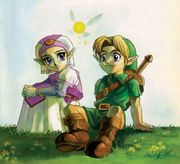
during the Graduation Ceremony, Zelda walks into the room in front of Link, who is bowing down respectfully. Link then looks up and gasps, blushing at her in amazement. He is then scolded by Chancellor Cole for raising his head without permission. Later, when Zelda's spirit is separated from her body following the first encounter with Chancellor Cole and Byrne, Link is the only one who can see her besides the Lokomos, demonstrating a clear and strong bond between himself and the Princess. After Zelda and Link defeat Byrne in the Tower of Spirits, Byrne, disbelieving, comments that he was beaten by two humans. Zelda, while still possessing a Phantom, says that when she and Link combine their strength, no one can defeat them. Link turns to her, surprised. The background turns white and Zelda's Lullaby plays as they both laugh and high-five, gazing at each other all the while. Toward the end of the game, before the final battle against Malladus, Zelda is reunited with her body, and is no longer able to levitate. Link runs underneath her to catch her as she falls, and she lands on top of him and knocks them both to the ground as well as knock Link out for a few seconds. Upon awakening, Zelda, overjoyed to have her body back, embraces Link, causing him to blush. Finally, after Malladus is defeated, Zelda and Link watch Anjean and Byrne's spirits ascend to the heavens. The camera then lowers to show Zelda and Link holding hands while Zelda's Lullaby plays in the background. After the credits, a short cut scene shows Zelda gazing at a picture of Link on the Spirit Train with her flying beside him, which she keeps on her desk. she may also wave at Link depending on his answer to a question Zelda asked before.
Skyward Sword has several noticeable romantic moments between Link and Zelda. Early in the game, Zelda wants Link to be the first to see her outfit for the Wing Ceremony. She worries over him and she does not want him to fail at becoming a knight. When Link's Crimson Loftwing is hidden by Groose, Zelda assists Link in finding his Loftwing. After Link wins the Wing Ceremony, Zelda jumps off the ledge and Link catches her almost as if she was expecting him to. She then congratulates him on winning. Afterwards, Zelda mentions that she is very happy to be atop the Statue of the Goddess with him. She also gets extremely close to him and almost implies that the two are to kiss, before she pushes him off the statue. Afterward, Zelda bashfully asks Link to go out flying which they do. She then tells Link how amazing the day was, and that she would remember it forever. At the Temple of Hylia, when Zelda states she must seal herself to keep Demise in place, she sheds tears of sadness and states before all this, she was happy just being with Link on Skyloft, demonstrating a deep level of feelings for Link. Link desperately tries to stop her and when she is sealed, Link lowers his head in sadness, showing his deep feelings for her. Much later in the game, when Link releases Zelda from her sealed state, Link runs up and catches her from falling and both of them hug and walk out smiling at each other, holding hands, before Ghirahim ruins the tender moment. During the ending, Zelda asks what Link will do now. Link sweetly smiles at her while their Loftwings fly off toward the sky, implying that he chose to stay on the Surface to live with Zelda.
A Link Between Worlds features some gossip told to Link by the Rumor Guy. He tells Link that one of the castle staff had seen Zelda sneaking off every night. When she followed her, she saw Zelda staring at the painting in Hyrule Castle depicting the Link and Zelda from A Link to the Past cuddling with each other, implying they became more intimate with each other. This also hints the Zelda in A Link Between Worlds wants to have a similar relationship with the Link of her time.
The game creators also seem to be fond of the idea of romance between the characters.[1]
Though never directly stated in-game, Shigeru Miyamoto revealed in an interview conducted by Famimaga 64 that Navi is jealous of Princess Zelda and has feelings for Link.[2]
Another less popular theory among fans is that Link and Zelda are related by blood, either as siblings or more distantly. Even though rumors to this effect started with the infamous "Save the Princess... Zelda is your... ... ..." line from A Link to the Past (later reported as a mistranslation), the theory generally revolves around the Link and Zelda from Ocarina of Time.
A possible indication of a blood relation between the two in Ocarina of Time is their physical resemblance: they both have blonde hair, blue eyes, and similar facial features. They also have similarly shaped heads. Graphics limitations could be responsible for some of this similarity, however. Certain dialogue could also be perceived as implying a blood relation: the ghost Sharp comments that Link reminds him of Zelda, and that Link "may have some connection with the Royal Family".[3] Link's connection to the Royal Family is highlighted throughout the game, with Link often playing Zelda's Lullaby to verify it. The fact that Impa agrees to teach a strange boy a song only Royal Family members are allowed to know could also be interpreted as a hint at Link's blood relation to Hyrule's Royal Family. [4]
Additionally, Zelda seems to recognize Link's name upon their first meeting.[5] This could be attributed to her prophetic abilities, although the boy in her dreams seemed to be a largely abstract figure, with no defining traits aside from the presence of a guardian Fairy and a Spiritual Stone. This line of dialogue has often been regarded as a sign that the two have met before, although this could only have occurred when Link was a baby per the Deku Tree Sprout's account of Link's coming to Kokiri Forest. It is also worth noting that while the King of Hyrule is clearly identified as Zelda's father, no mention is made of a Queen. Meanwhile, Link's mother is stated to have died shortly after reaching the forest, but no information is given concerning his father. Given these facts, it is possible that Zelda and Link share the same parents, making them siblings.
Royal Family of Hyrule[]
The Royal Family of Hyrule does not appear in this game, however, the game's end implies its
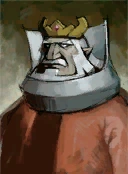
creation. Zelda, not as a princess, but as the daughter of Skyloft's Headmaster, and Link stay on the surface after the destruction of Demise, and are implied to form the kingdom of Hyrule, presumably with Link and Zelda as the ruling family. The sacred status of the Hyrule Royal Family may be seen as its connection to Hylia.
Sealed Grounds[]
The Sealed Grounds, formerly known as Hylia's Realm, is a location from The Legend of Zelda: Skyward Sword.
Future[]
It is possible the Sealed Temple later became the Temple of Time seen in The Legend of Zelda:
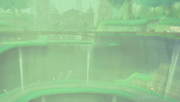
Ocarina of Time. This is due to to structural similarities, such as a sword pedestal in the back, large doors and tall ceiling. There is also the war of time that means it could become the Temple of Time. The town center could also be what becomes of the circular area outside, due to the circular nature and proximity to the Temple of Time. Additionally, the Temple of Time from The Legend of Zelda: Twilight Princess is located in Faron Province, which corresponds to the Sealed Grounds' location. Though Hyrule Historia does not confirm this theory directly, it does state that this is one possibility.
The Seal[]
It is possible that the seal holding back Demise has a relationship to the Fused Shadow from The Legend of Zelda: Twilight Princess. Both are ancient artifacts made of a dark substance that bears considerable magical power, and are both capable of transforming those that come in contact with into massive, twisted versions of themselves. Additionally, the process of the seal absorbing the Imprisoned greatly resembles the appearance of the Fused Shadows reconstituting themselves, as the massive monster in question explodes into many black fragments, which are then pulled into a central point.
Silent Realm[]
The Silent Realm is theorized to be the Sacred Realm mentioned throughout the Zelda series. In

Skyward Sword, Link obtains all three pieces of the Triforce in a place which appears to be the Silent Realm, given the area's identical appearance, method of entry, and Link's lack of items in the area. Because the stories of the creation of Hyrule state that the Triforce was left in the Sacred Realm, it would make sense that in Skyward Sword, which is generally accepted as the first game in the chronology of the series, the Triforce would be found in the Sacred Realm. The Silent Realm also changes to appear golden upon Link's acquisition of the full Triforce, similar to the Sacred Realm's description as the "Golden Land". However, the nature of the Silent Realm is distinctly different from that of the Sacred Realm. While both are equivalent worlds to Hyrule, the Silent Realm is a spirit world which only Link can enter, leaving Fi, his items, and his own physical body behind. The Sacred Realm, however, is a normal physical world, which any person can enter with their own body and equipment. It should also be noted that according to Fi's explanation of the Silent Realm it is a spirit world that only the goddess's chosen hero can enter, while the Sacred Realm can be entered by beings who are not the Goddess's chosen hero such as Ganondorf in Ocarina of Time.
Split Timeline[]
It is speculated by some that alternate worlds such as the Twilight Realm and Termina may be unaffected by the timeline split. However, while these two realms are alternate dimensions, there is no evidence to support the idea that they exist outside of linear time. Both realms have demonstrated the ability to receive beings from the Child Timeline and return them to the Child Timeline when they exit back into Hyrule. There is no reason to believe that these two realms would only exist as a single timeline, or that they could "prioritize" inputs from one timeline, and later output these into both the timelines.
In addition, the renowned Youtube show, Game Theory, dismissed the Zelda Timeline, particularly the Defeat Timeline (in where Link fails on his quest) on the grounds that "the hero cannot be simultaneously victorious and defeated". Elaborating, he explained that with Link defeating Gannondorf, two perfectly possible timelines are created; However if Link dies at any point in his journey another separate timeline is created. Explaining that the only way for all 3 timelines to exist is the Many Worlds Theory (the theory that all possible pasts and futures exist in separate timelines).
Stallord[]
"You still live... How astonishing. No wonder some call you "hero". But this is truly a bittersweet reunion... Truly! For I fear this is the last time I will see you alive!" — Zant
Twilit Fossil, Stallord (蘇生古代竜 ハーラ・ジガント Sosei Kodai Ryū Hāra-Jiganto?, Resurrected
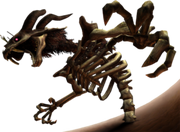
Ancient Dragon Hahra Gigant) is the boss of the Arbiter's Grounds, the fourth dungeon in The Legend of Zelda: Twilight Princess. Stallord is the skeleton of a dead beast found inside the Arbiter's Grounds. It has a roughly humanoid upper body protruding from a pit of sand, and a horned animal head comparable to a goat or dragon. Its lower body is never seen; in fact, whether its lower portions were even present at the time is unknown. Several weapons are embedded in the beast's skull, possibly the cause of its death. The music played during the battle against Stallord incorporates, partly, reinstrumentalized versions of the music played during the battles against King Dodongo and Volvagia in The Legend of Zelda: Ocarina of Time. By name, it is the king of the Stalfos in Arbiter's Grounds.
Volvagia[]
Stallord may be the dragon Volvagia from Ocarina of Time, as he was never revived in the Twilight Princess timeline and has a very similar appearance (aside from being only a skeleton), abilities (fire breathing) and the same music. However, this seems unlikely, as Stallord is considerably bigger than Volvagia was, and Stallord is found in the Arbiter's Grounds which is directly across from Death Mountain where Volvagia had lived. There are also physical differences such as Stallord having some hair around its neck, while Volvagia had a mane of flames; Stallord's dental structure differs from Volvagia's; Stallord has ten digits in all while Volvagia only has six; and Stallord has relatively long arms, while Volvagia's in comparison are very short.
Another way Stallord could have been Volvagia is that technically, Link never fought Volvagia in the first place. Due to Princess Zelda sending Link back in time, and Link stopping Ganondorf from taking the Triforce of Power, Volvagia was never killed by Link in the child timeline. Some believe that as a last resort, Ganondorf created a few monsters (one being Volvagia) but was arrested by the Sages. The reason Stallord was in Arbiter's Grounds may be because Volvagia couldn't be killed, so they sealed it inside its chamber to keep it from doing any harm. How Volvagia died however, is a different story. It very well could have been starvation. The vast numbers of Staltroops seemed to wear similar armor to the Knights of Hyrule, so they may have been the warriors that died helping to take down and seal up Volvagia.
King Dodongo[]
o a theory that Stallord is King Dodongo, another boss from Ocarina of Time, which is reptilian in appearance, similarly to Stallord. Sections of the music played during the boss battle against King Dodongo are reused during the battle against Stallord. However, this theory is also discredited based on several physical differences (arm length, digit number, general proportion of limbs, torso, hair and head). Also, the Desert and the Mountains are very far apart, and when King Dodongo was defeated, his body was apparently trapped in the lava of his own chamber.
Dark Dragon[]
It is also possible that Stallord is based on General Onox's Dark Dragon form from The Legend of Zelda: Oracle of Seasons. The body proportions, in terms of arm length, horn size and shape, and facial structure, are quite similar. In addition, Stallord's lack of a lower half rings similar to how Onox has a tail and no hind legs. However, the Dark Dragon only has four fingers, unlike Stallord, and also had wings, which Stallord lacks (although they may have been buried in the sand before the events in the game). Also the Dark Dragon only seems to have eight teeth during its boss fight, unlike Stallord, which has ten teeth (although arguably, not all of the Dark Dragon's teeth were seen). Lastly, Holodrum and Hyrule are very far apart. However, it should be noted that Onox's speech before the final battle implies that he was actually native to the Dark Realm and not to Holodrum.
Execution Beast[]
Another possibility is that Stallord was used for execution when the Arbiter's Grounds were still in use, due to Stallord's chamber being situated directly beneath the chamber where those condemned were banished to the Twilight Realm. The chamber itself seems like it was designed so that several people would be placed on the pillar and lowered to the bottom where Stallord would subsequently devour them. Supporting this is the abundance of Staltroops, being animated skeletons, which are theorized to be prisoners killed by Stallord.
Other Origins[]
Another possibility is that Stallord was simply an unnamed monster killed prior to the game by another hero. Throughout the Arbiter's Grounds, wall engravings show a figure with a shield fighting a large monster, possibly Stallord, which may suggest that Stallord's first death was because of an ancient hero and not of natural causes. Shapes similar to Stallord's head are on all the doors in the Arbiter's Grounds.
The chamber Stallord is found in shares a couple of shapes similar to the Sealed Grounds in Skyward Sword: downward-pointed cone (although this is not the shape of the chamber itself, but rather of the sand during the first part of the battle), and spiral (the tracks Link rides, and the edge of the Sealed Grounds pit). Stallord also has a sharp object embedded in the top of it's skull, a similarity it shares with Demise. It may be that the game's designers intended to infer that the two bosses are somehow linked, or were merely drawing on a previous game for design. The similarities could also be purely coincidental. In SS the Sealed Grounds and Gerudo are far apart, diminishing the likelihood that Stallord is Demise's remains.
Thrill Digger Area[]
"This is the Thrill Digger area. It is a game run by a Mogma called Tubert. It appears as though there is another Mogma here. There is a 95% chance that he has some information." — Fi The Thrill Digger area is a cave that appears in The Legend of Zelda: Skyward Sword. The entrance located behind a bombable wall between two huts in a Bokoblin camp in Eldin Volcano. As its name implies, it is where Mr. Tubert's Thrill Digger mini-game can be played. Besides Thrill Digger, the cave features Rupee Ore on the walls of the cave, which Link can shoot to make them drop Rupees who value is based on the color of the Ore. However hitting Black Rupee Ore will drop Rupoors. There also a few digging spots around the fenced in game area. Link can also chat with Mr. Tubert by sitting on the chair near him (which is useful for healing Link if he takes to much damage from the Bomb Flowers in Thrill Digger). If Link asks him all three available questions then quits talking, Mr. Tubert will tell Link about the Rupee Ore found in his cave. There is also a stone tablet near the exit which Link can read to receive a helpful tip on playing Thrill Digger.
Besides Mr. Tubert, there is also another Mogma named Zanc appears in the back of the cave and will offer Link a hint on how to win at Thrill Digger in exchange for 20 Rupees. Later in the game, Link can play the Goddess's Harp near a swarm of Blessed Butterfly to summon a Gossip Stone.
Rupee Ore Mine[]
The Rupee Ore found in the Thrill Digger area may explain where all the Rupees (and dreaded Rupoors) in Thrill Digger come from. It also may indicate that at some point after the defeat of Demise it may have been mined for its valuable Rupee Ore. If Eldin Volcano eventually became Death Mountain (possibly due to it becoming less volcanically active), then most of the Rupee Ore may have been mined out (due to the lack of Rupee Ore on Death Mountain), yet some of it remained in smaller quantities inside the rocks for Death Mountain, which when the rocks where broken open turned it Rupees. This would explain why Rupees can often be found by breaking the small rocks on Death Mountain in Ocarina of Time.
Tingle[]
A character named Purlo appears in The Legend of Zelda: Twilight Princess. Purlo is possibly a
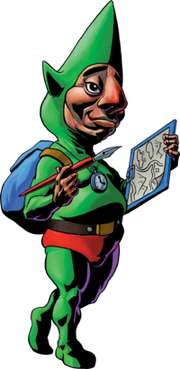
reference to what Tingle would look like if he was a more realistic character. Purlo is the manager of the STAR Game in Hyrule Castle Town, and he wears a similar costume to Tingle. He is also obsessed with Rupees, much like Tingle. Unlike Tingle though, Purlo has an unfriendly attitude towards others.
